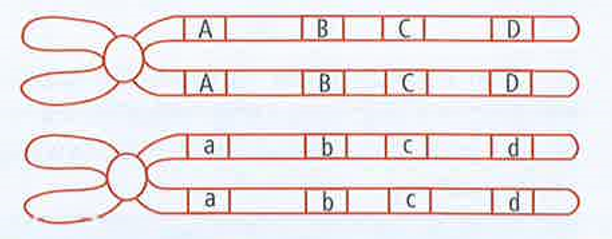In meiosis,
I. every chromosome behaves independently,
II. Homologous chromosomes show pairing.
III. Found in somatic cells.
IV. Crossing over occurs.
Choose the option with correct statement(s).
Only IV
I and III
II and IV
I and II
The correct Answer is:C
Step by step video, text & image solution for In meiosis, I. every chromosome behaves independently, II. Homologous chromosomes show pairing. III. Found in somatic cells. IV. Crossing over occurs. Choose the option with correct statement(s). by Biology experts to help you in doubts & scoring excellent marks in Class 12 exams.
Topper's Solved these Questions
- BOOK - ARIHANT NEETCHAPTER - CELL CYCLE AND CELL DIVISIONEXERCISE - Chapter Exercises (B) Medical entrances special formate questions (Match the columns)1videos
CELL CYCLE AND CELL DIVISION
- BOOK - ARIHANT NEETCHAPTER - CELL CYCLE AND CELL DIVISIONEXERCISE - Chapter Exercises (B) Medical entrances special formate questions (Assertion and Reason)5videos
CELL CYCLE AND CELL DIVISION
- BOOK - ARIHANT NEETCHAPTER - CELL CYCLE AND CELL DIVISIONEXERCISE - Chapter Exercises (A) Taking it together (Assorted Questions of the Chapter of Advanced Level Practice)1videos
CELL CYCLE AND CELL DIVISION
- BOOK - ARIHANT NEETCHAPTER - BREATHING AND EXCHANGE OF GASES EXERCISE - Chapter exercise C (Medical entrances gallery )54videos
BREATHING AND EXCHANGE OF GASES
- BOOK - ARIHANT NEETCHAPTER - CELL: THE UNIT OF LIFEEXERCISE - Chapter Exercises C Medical Entranes Gallery (Collection of questions Asked in NEET & Various Medical Entrance Exams )118videos
CELL: THE UNIT OF LIFE
Similar Questions
Knowledge Check
- Question 1 - Select One
Prophase of meiosis includes
I. Leptotene
II. Pachytene
III. Cytokinesis
IV. Karyokinesis
Choose the option with correct statement(s).AOnly IBI and IICI,II and IVDOnly II - Question 2 - Select One or More
Consider the following four compounds I, II, III, and IV.

Choose the correct statement(s).AThe order of basicity is II>I>III>IV.BThe magnitude of pKb difference between I and II is more than that between III and IV.CResonance effect is ore in III in IV.DSteric effect makes compound IV more basic than III - Question 3 - Select One
The proteins present in myofilaments are
I. gloulin
II. Actin
III. Haemoglobin
IV. Tropomyosin
Choose correct option with correct statements (s).AI and IIIBII and IVCIII and IVDOnly IV
Prior to meiosis, DNA replication occurs, so each chromosome contains two sister chromatids that are identical to the original chromosome. Meiosis is divided into two nuclear divisions: meiosis I and meiosis II. Each of these nuclear divisions shares many aspects of mitosis and can be divided into the same phases: prophase, metaphase, anaphase, and telophase, however, between the two divisions, DNA replication does not occur. Through this process, one diploid cell will divide into four haploid cells. During meiosis I. the pairs of homologous chromosomes are separated from each other. During prophase I, the homologous chromosomes line up together. During this time, crossing over canoccur(theexchangeofDNA betweenhomologous chromosomes). Crossing-over increases the new allele combinations in the gametes. Without crossing-over, the offspring would always inherit all of the many alleles on one of the homologous chromosomes. (An allele is an alternative form of a gene which is located at a specific position on a specific chromosome.) Because of crossing-over, the alleles on the homologous chromosomes can be scrambled to pass on unique combinations of alleles on the chromosome. Also, during prophase I. the spindle forms and the chromosomes condense as they coil up tightly. The spindle has the same function as in mitosis.
How many haploid cells will result from one diploid cell after it has undergone meiosis?View SolutionGiven diagram shows a pair of homologous chromosomes during meiosis

Maximum crossing over will occur between genesView SolutionWhich of the following are types of granulocytes'?
I. Ncutrophils II. Acidophils
III. Lymphocytes IV. Monocytes
Choose the option with the correct: statements.View SolutionFour different steps that occur during meiosis are given in the following list.
(i) Complete separation of chromatids
(ii) Pairing of homologous chromosomes
(iii) Lining up of paired chromosomes on equator
(iv) Crossing over between chromatids
Select the correct sequential arrangement of the steps.View SolutionSynapsis
I. is pairing of homologous chromosomes.
II. Is also called syndesis.
III. When begins at the centromere and proceeds towards the ends, is called proterminal.
IV. When begins at and proceeds towards centromere, is called procentric.
Choose the correct option with correct statement(s).View Solution

